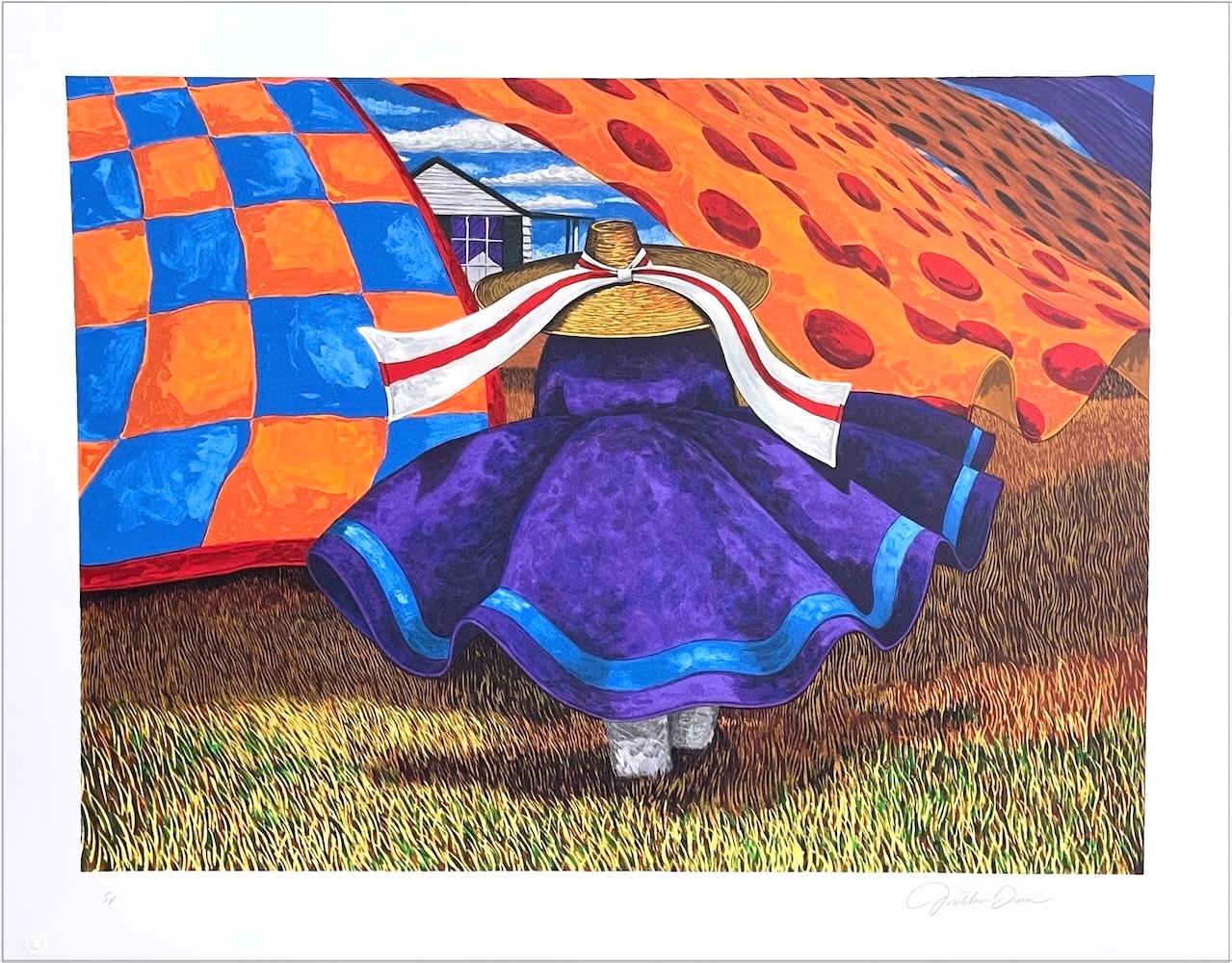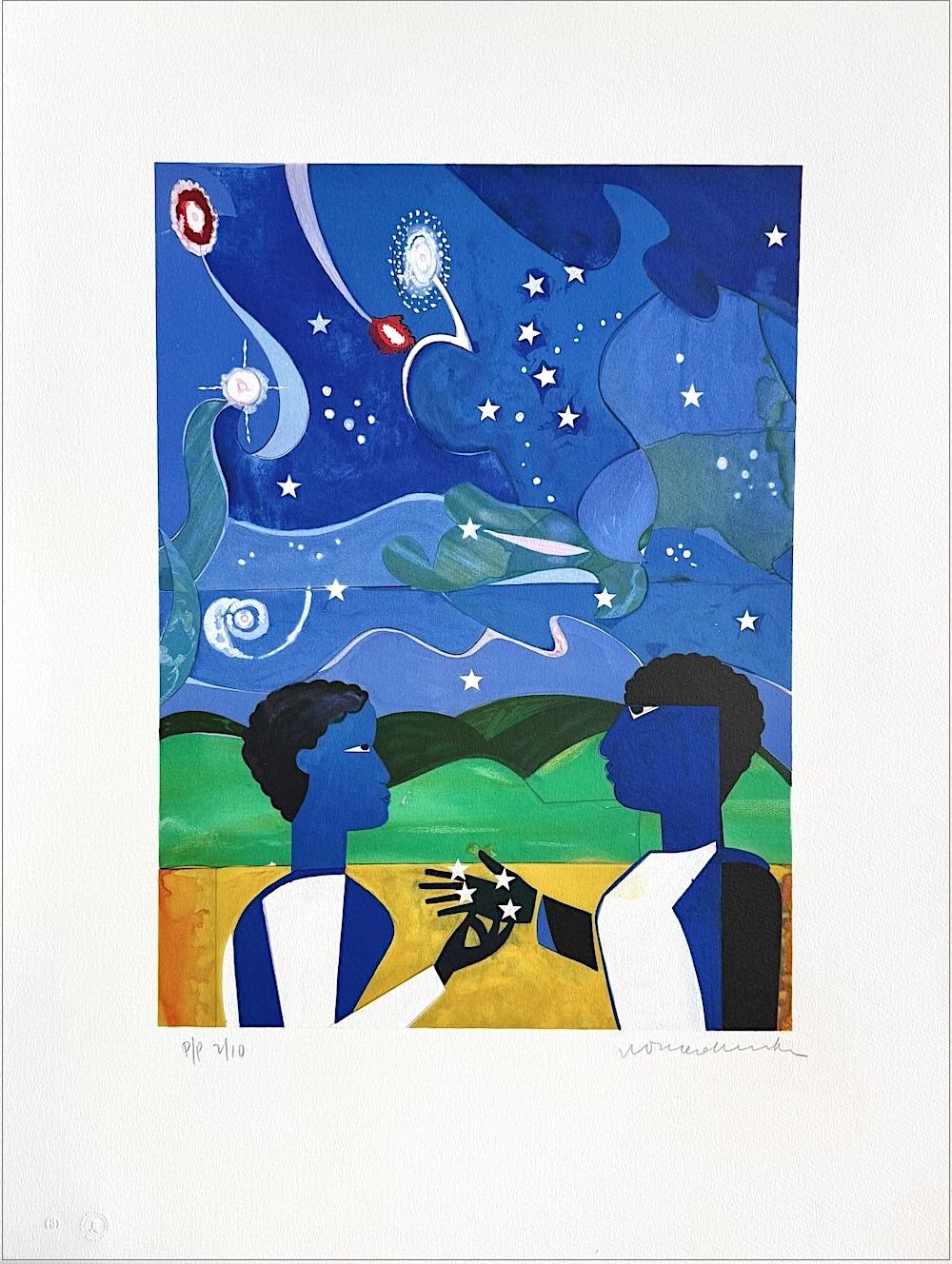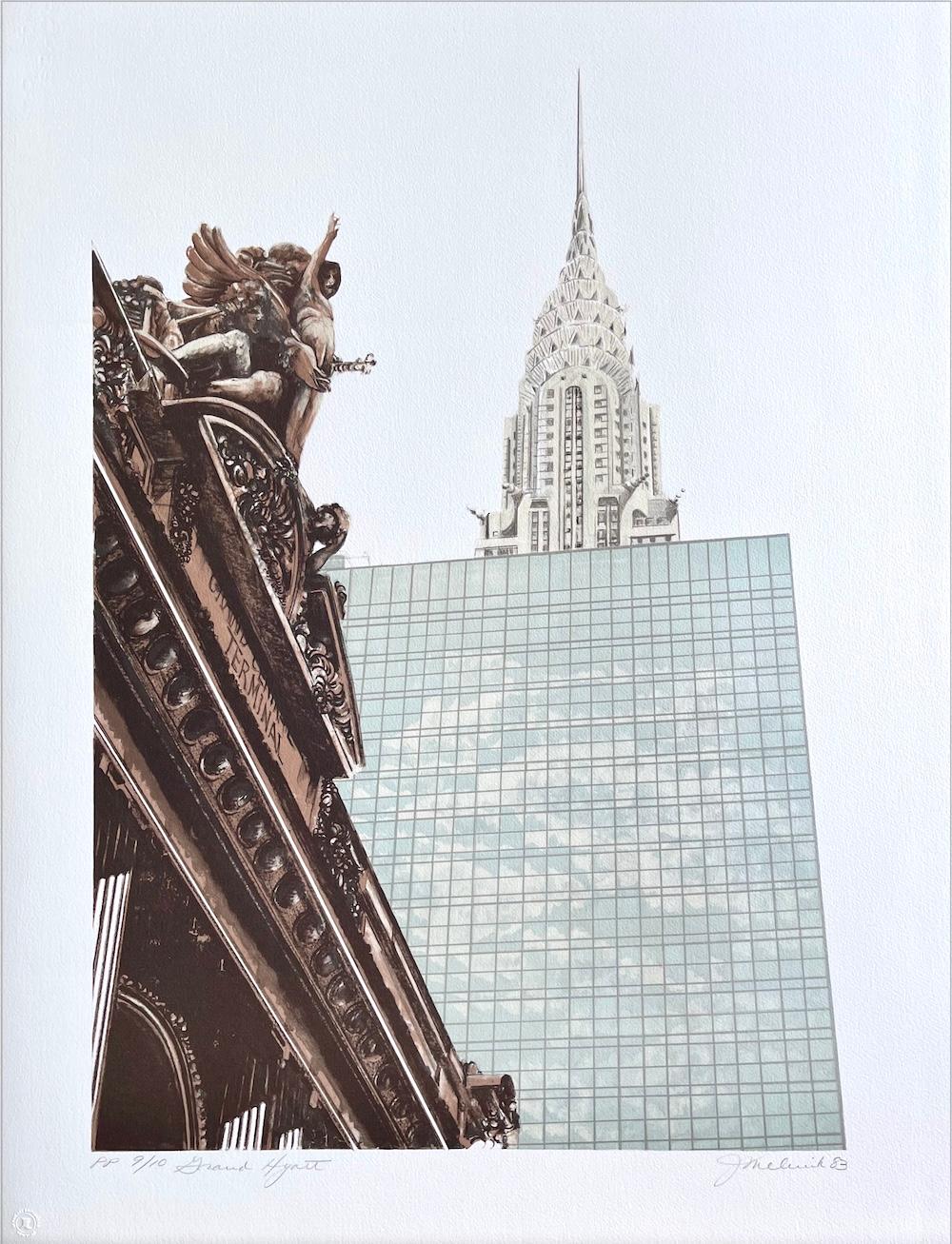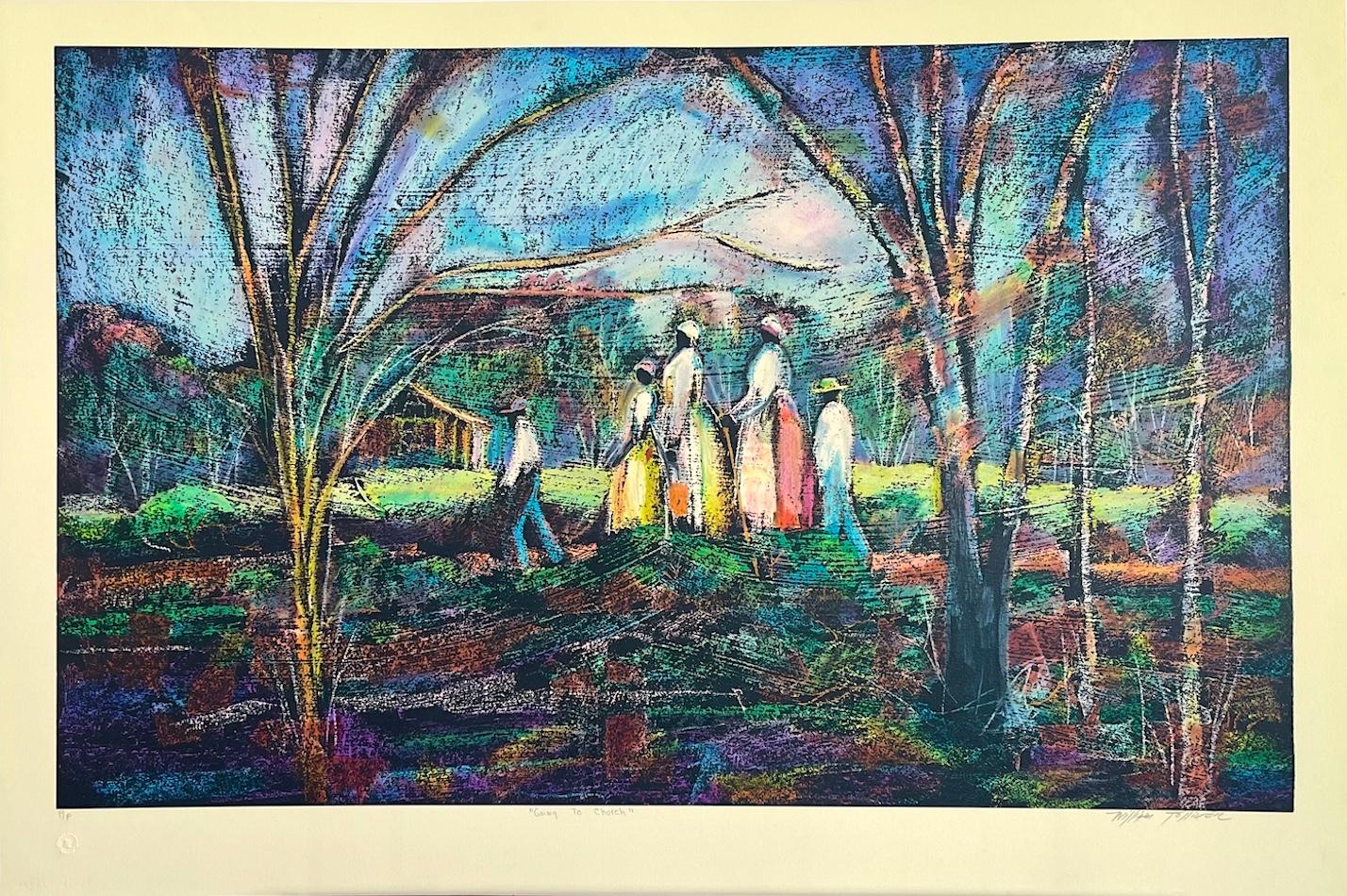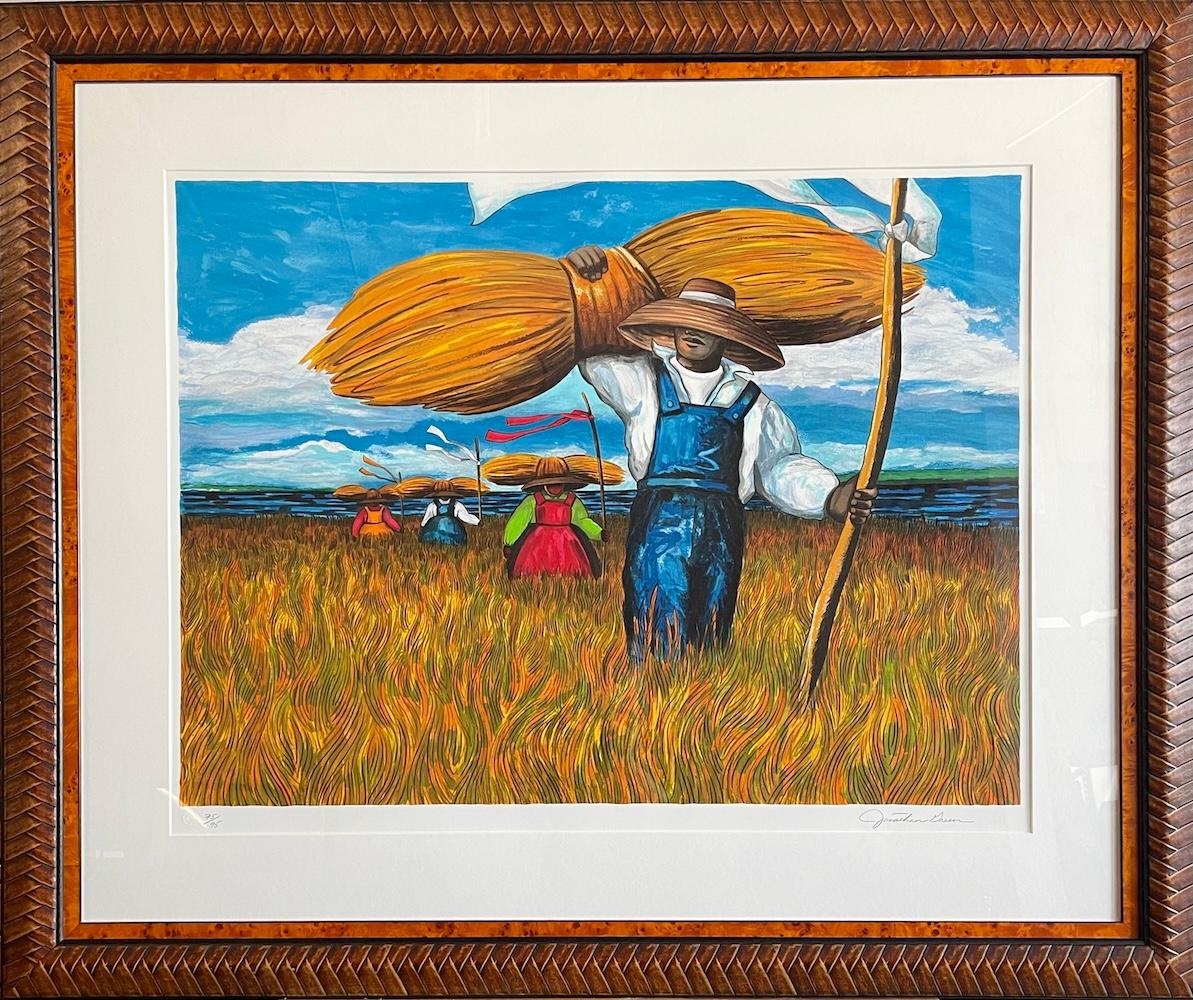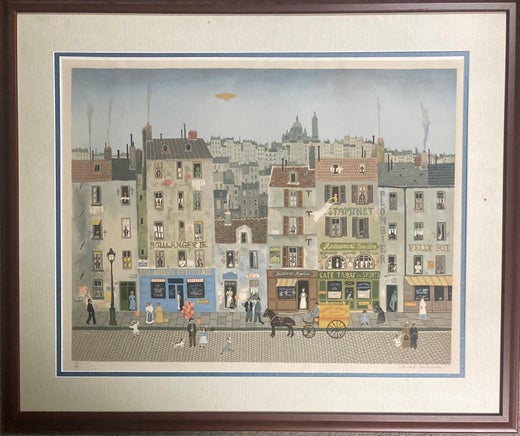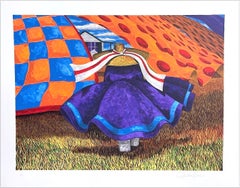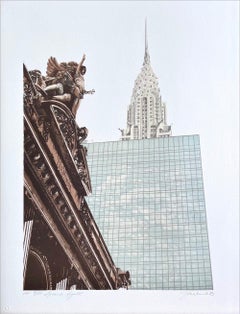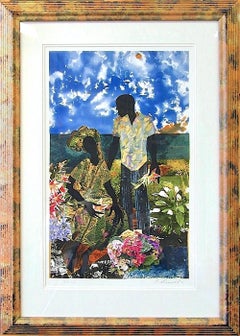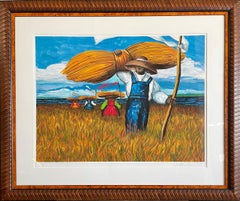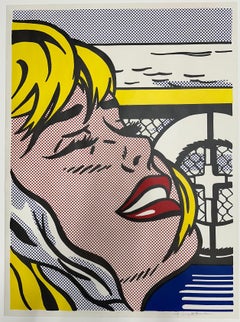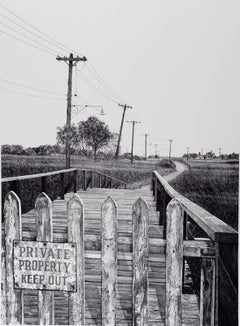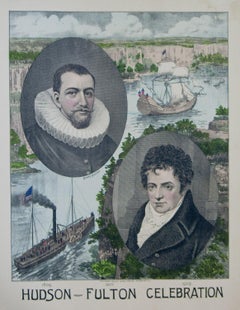Items Similar to LES QUATRE SAISONS DE L'AMOUR Boxed Set of 4 Signed Lithographs, Paris Lovers
Video Loading
Want more images or videos?
Request additional images or videos from the seller
1 of 20
Michel DelacroixLES QUATRE SAISONS DE L'AMOUR Boxed Set of 4 Signed Lithographs, Paris Lovers1994
1994
About the Item
LES QUATRE SAISONS DE L'AMOUR is a very distinctive boxed set of 4 signed original hand drawn limited edition lithographs by the popular French artist Michel Delacroix; well known for his naif style paintings of a city he calls "the Paris of then." Each print was proofed and printed using hand lithography techniques on archival Arches paper 100% acid free. This exquisite portfolio, LES QUATRE SAISONS DE L'AMOUR, captures the nostalgic charm and romance of lovers in Paris. The collection features heartwarming scenes of loving couples staged during each of the four seasons: Spring - "Soyez Heureux!"(Be Happy), Summer - "Le Bonheur"(Happiness), Autumn - "Sur le Banc"(On The Bench), and Winter - Déclaration d'amour sous la neige"(Declaration of Love In The Snow) along with romantic poetic quotes by Martin Luther, Victor Hugo, Voltaire, and George Sand apropos to the imagery. LES QUATRE SAISONS DE L'AMOUR is truly a wonderful set of visual expressions of love and happiness created by the well loved French artist Michel Delacroix.
Print size - 19 x 22 inches
Image size - 16 x 13 inches
Edition size - 200 Numbered
200 Roman Numeral
40 Artists Proofs
10 HC
Year published - 1994
Portfolio box - 24 x 20 inches covered in bright red cloth with metallic gold stamped title
Parchment paper sheets printed with poetry quotation for each season.
Portfolio set is in excellent condition, lithographs are hand signed in pencil by Michel Delacroix, fresh vivid colors, unframed, Certificate of Authenticity provided.
Printed in 1994 at JK Fine Art Editions Co., NJ, from the master printers private collection
About the artist Michel Delacroix:
Michel Delacroix was born in 1933 on the Left Bank, in the 14th Arrondissement of Paris. He started painting at the early age of seven just as the German Occupation of Paris began. Paris as it was during the Occupation is the Paris that appears in his paintings even today; there was a virtual absence of automobiles and streetlights, the city was quiet and isolated. His cityscapes display a simpler Paris of the past, of his boyhood rather than the urban metropolis of today.
Delacroix was educated at the Ecole des Beaux-Arts in Paris and spent years experimenting with several different painting styles until, at the age of 35, he began producing works in the Naïf tradition, his characteristic style. He experimented with various painting styles until he discovered his unique naif style that, with its flat, almost two-dimensional representations combined with strong colors, evokes the atmosphere of the past.
Throughout the course of his career, Delacroix has been honored with numerous awards including the Grand Prix des Amateurs d’Art, Paris (1973), the Grand Prix de la Cote d’Azur, Cannes (1976) and the Premier Prix de Sept Collines, Rome (1976). His work can be found in several public and private collections including the Fonds National d’Art Contemporain in Paris and the Musée International d’Art Naïf. Delacroix’s paintings have been featured in over 300 solo exhibitions in the United States alone.
- Creator:Michel Delacroix (1933, French)
- Creation Year:1994
- Dimensions:Height: 22 in (55.88 cm)Width: 19 in (48.26 cm)
- Medium:
- Movement & Style:
- Period:
- Condition:Excellent condition, unframed, pencil signed by Michel Delacroix, Certificate of Authenticity provided, from the master printers private collection.
- Gallery Location:Union City, NJ
- Reference Number:1stDibs: LU83239568522
Michel Delacroix
Internationally renowned French painter Michel Delacroix is an acclaimed master of the naïf tradition and one of the most popular collected artists in the world today. A self-styled painter of dreams and the poetic past, Delacroix continued to paint and experiment with a variety of techniques and styles before eventually developing his signature style, depicting scenes of Paris as a happy, timeless and magical place. He has been exhibiting one-man shows all over the world, and his works are collected by major museums and private collectors worldwide.
About the Seller
4.9
Platinum Seller
Premium sellers with a 4.7+ rating and 24-hour response times
Established in 1975
1stDibs seller since 2018
678 sales on 1stDibs
Typical response time: <1 hour
- ShippingRetrieving quote...Shipping from: Union City, NJ
- Return Policy
Authenticity Guarantee
In the unlikely event there’s an issue with an item’s authenticity, contact us within 1 year for a full refund. DetailsMoney-Back Guarantee
If your item is not as described, is damaged in transit, or does not arrive, contact us within 7 days for a full refund. Details24-Hour Cancellation
You have a 24-hour grace period in which to reconsider your purchase, with no questions asked.Vetted Professional Sellers
Our world-class sellers must adhere to strict standards for service and quality, maintaining the integrity of our listings.Price-Match Guarantee
If you find that a seller listed the same item for a lower price elsewhere, we’ll match it.Trusted Global Delivery
Our best-in-class carrier network provides specialized shipping options worldwide, including custom delivery.More From This Seller
View AllFARM WOMAN Signed Lithograph, Lowcountry Landscape Gullah Geechee Culture Quilts
By Jonathan Green
Located in Union City, NJ
FARM WOMAN, by JONATHAN GREEN, is a hand drawn, limited edition lithograph printed in 19 colors using hand lithography techniques on archival printmaking paper, 100% acid free. FARM ...
Category
Early 2000s Contemporary Portrait Prints
Materials
Lithograph
NEW YORK CITY GRAND HYATT Signed Lithograph, Grand Central Terminal NYC Landmark
By Joan Melnick
Located in Union City, NJ
NEW YORK CITY: GRAND HYATT is an original hand drawn lithograph created in 1983 by the NY woman artist, Joan Melnick. NEW YORK CITY: GRAND HYATT was Inspired by the architectural des...
Category
1980s Contemporary Landscape Prints
Materials
Lithograph
GARDEN ROMANCE Signed Lithograph, Black Couple, Collage Portrait Lovers, Flowers
By James Denmark
Located in Union City, NJ
GARDEN ROMANCE by the artist James Denmark is an original hand drawn, limited edition lithograph(not a photo reproduction or digital print) printed on archival Somerset paper using traditional hand lithography techniques. GARDEN ROMANCE is one of Denmark's expressive, colorful collage compositions of everyday African American life - a lovely flower garden scene featuring a romantic black couple, the woman seated amid the blossoming plants wearing a green and yellow paisley print dress and head wrap; her standing male companion with flower in hand, dressed in blue denim jeans, and pastel color patchwork print shirt. Vivid coloration, watercolor patterns, and collage effect textures captivate the eye with visual variety in a striking palette of blues, greens, white, red, orange, magenta, touches of yellow, lavender and dark black - a fine example of the intricacies of hand lithography!
Print size - 32 x 21.25 in., archival framing, double mat, excellent condition, pencil signed and numbered - Certificate of Authenticity provided
1 / 15 H.C. by James Denmark, publisher's chop embossed lower left corner
Edition size - 250, plus proofs
Year published - 1996
Printer - JK Fine Art Editions Co. NJ
Publisher - Mojo Portfolio...
Category
1990s Contemporary Portrait Prints
Materials
Lithograph
SWEETGRASS CARRIERS Signed Lithograph Framed, Black Farmer Lowcountry SC Gullah
By Jonathan Green
Located in Union City, NJ
SWEETGRASS CARRIERS is a hand drawn, limited edition lithograph (not a photo reproduction or digital print) by the renowned American artist JONATHAN GREEN printed in 17 colors using hand lithography techniques on heavyweight archival Arches paper, 100% acid free. SWEETGRASS CARRIERS depicts a black farmer standing in a field of golden sweetgrass dressed in a straw sunhat, white shirt and rugged blue denim overalls accompanied by three female field workers clothed in colorful orange, blue and red bell shaped dresses all carrying bundles of freshly harvested sweetgrass. The expansive field of golden yellow, orange, and green blades of grass is backed by a horizon line of deep blue water and distant green trees enlivened by white clouds sweeping across a clear blue sky. Truly an impressive agricultural landscape scene reflecting back on local traditions of Geechee Gullah culture, Lowcountry South Carolina.
Impressive size - large horizontal format, handmade lithograph, fine impression, vivid colors, hand signed and numbered 75/95 by Jonathan Green, professionally framed, double frame - wove textured moulding and burl wood style liner, archival framing materials, publishers chop mark embossed on lower margin, Print documentation/ Certificate of Authenticity will be provided.
Framed size - 44 x 55 in. with frame
Print size - 33.5 x 42.5 inches unframed print size
Image size - 27 x 36.5 inches
Edition size - 95, plus proofs
Year published - 1999
Printed at J K Fine Art Editions Co., NJ
Publisher - Mojo Portfolio, NJ
Sweetgrass grows in the moist, sandy soils near oceans and marshes. It is harvested in the spring and summer by "pullers" who slip it from its roots and place it in the sun to dry. Sweetgrass baskets...
Category
1990s Contemporary Portrait Prints
Materials
Lithograph
GOING TO CHURCH Signed Lithograph, Southern Landscape, African American Heritage
By William Tolliver
Located in Union City, NJ
GOING TO CHURCH was the very first limited edition print created by the self-taught African American artist William Tolliver (b.1951-2000) in 1987. GOING TO CHURCH is an original han...
Category
1990s Contemporary Portrait Prints
Materials
Lithograph
TWO WORLDS, FACES OF THE FUTURE Signed Lithograph, Figurative Collage Night Sky
By Romare Bearden
Located in Union City, NJ
TWO WORLDS, FACES OF THE FUTURE is a hand drawn, limited edition color lithograph by the renowned American artist Romare Bearden, printed using hand lithography techniques on archival Arches printmaking paper, 100% acid free. TWO WORLDS, FACES OF THE FUTURE is a multicolored collage landscape portraying a mysterious, jigsaw-shaped starry night sky in shades of deep blue, hues of bright green, golden yellow, and touches of red. In the foreground of TWO WORLDS, FACES OF THE FUTURE two human figures stand face to face exchanging stars beneath a celestial blue sky showered with twinkling lights. Bearden created this image bearing in mind the importance of advancement through education. This very unique Romare Bearden lithograph...
Category
1980s Contemporary Portrait Prints
Materials
Lithograph
You May Also Like
Shipboard Girl
By Roy Lichtenstein
Located in Miami, FL
Offset Lithograph from an edition of unknown size. Signed (rf Lichtenstein) in pencil lower right.. Publisher Leo Castelli Gallery, New York. Printed by Graphic Industries Inc., New...
Category
1960s Pop Art Portrait Prints
Materials
Lithograph
ROSIGNANO DAWN (DIPTYCH)
By Massimo Vitali
Located in Aventura, FL
Offset lithograph on paper. Each stamped and numbered on verso. Edition of 120. Size: 35.5 x 27.5 inches (each); 35.5 x 55 inches (total).
Artwork is in excellent condition. Certif...
Category
Early 2000s Photorealist Landscape Prints
Materials
Lithograph, Offset
$2,800 Sale Price
30% Off
Private Property (Jamaica Bay in Queens NY - now a runaway of JFK airport)
By Martin Levine
Located in New Orleans, LA
Private Property was created in 1982 and is #25 from an edition of 40.
Martin Levine (born 14 May 1945 in New York City) is an American artist.
Levine...
Category
1980s American Modern Landscape Prints
Materials
Lithograph
Hudson - Fulton Celebration 1809 - 1909 lithograph
Located in Paonia, CO
Hudson - Fulton Celebration is an original lithograph celebrating the 300 year anniversary of the discovery of the Hudson River. The image shows a portrait of Henry Hudson and a portrait of Robert Fulton...
Category
Early 1900s Other Art Style Portrait Prints
Materials
Lithograph
$520 Sale Price
22% Off
19th century color lithograph portraits ship seascape patriotic flags military
By Nathaniel Currier
Located in Milwaukee, WI
The present hand-colored lithograph is an excellent example of patriotic mid-nineteenth century American imagery. The print shows the battle and several of the major figures involved in the Battle of Lake Erie: At the center is a view of several frigates on the lake, embroiled in conflict. Above the battle is the quotation: "We have met the enemy and they are ours." Surrounding are laurel-lined roundels with portraits of Oliver Hazard Perry (1785-1819), Stephen Dicateur (1779-1820), Johnston Blakeley (1871-1814), William Bainbridge (1774-1833), David Porter (1780-1843), and James Lawrence (1781-1813) - all of these framed by American flags, banners and cannons. This print shows that the Battle of Lake Erie, part of the War of 1812, still held resonance for American audiences several decades later and was part of the larger narrative of the founding of the country.
9.5 x 13.5 inches, artwork
20 x 23.38 inches, frame
Entitled in the image
Signed in the stone, lower left "Lith. and Pub. by N. Currier"
Inscribed lower right "2 Spruce N.Y." and "No. 1"
Copyrighted lower center "Entered according to Act of Congress in the year 1846 by N. Currier in the Clerk's office of the Southern District of N.Y."
Framed to conservation standards using 100 percent rag matting and housed in a gold gilded moulding.
Nathaniel Currier was a tall introspective man with a melancholy nature. He could captivate people with his piercing stare or charm them with his sparkling blue eyes. Nathaniel was born in Roxbury, Massachusetts on March 27th, 1813, the second of four children. His parents, Nathaniel and Hannah Currier, were distant cousins who lived a humble yet spartan life. When Nathaniel was eight years old, tragedy struck. Nathaniel’s father unexpectedly passed away leaving Nathaniel and his eleven-year-old brother Lorenzo to provide for the family. In addition to their mother, Nathaniel and Lorenzo had to care for six-year-old sister Elizabeth and two-year-old brother Charles. Nathaniel worked a series of odd jobs to support the family, and at fifteen, he started what would become a life-long career when he apprenticed in the Boston lithography shop of William and John Pendleton.
A Bavarian gentleman named Alois Senefelder invented lithography just 30 years prior to young Nat Currier’s apprenticeship. While under the employ of the brothers Pendleton, Nat was taught the art of lithography by the firm’s chief printer, a French national named Dubois, who brought the lithography trade to America.
Lithography involves grinding a piece of limestone flat and smooth then drawing in mirror image on the stone with a special grease pencil. After the image is completed, the stone is etched with a solution of aqua fortis leaving the greased areas in slight relief. Water is then used to wet the stone and greased-ink is rolled onto the raised areas. Since grease and water do not mix, the greased-ink is repelled by the moisture on the stone and clings to the original grease pencil lines. The stone is then placed in a press and used as a printing block to impart black on white images to paper.
In 1833, now twenty-years old and an accomplished lithographer, Nat Currier left Boston and moved to Philadelphia to do contract work for M.E.D. Brown, a noted engraver and printer. With the promise of good money, Currier hired on to help Brown prepare lithographic stones of scientific images for the American Journal of Sciences and Arts. When Nat completed the contract work in 1834, he traveled to New York City to work once again for his mentor John Pendleton, who was now operating his own shop located at 137 Broadway. Soon after the reunion, Pendleton expressed an interest in returning to Boston and offered to sell his print shop to Currier. Young Nat did not have the financial resources to buy the shop, but being the resourceful type he found another local printer by the name of Stodart. Together they bought Pendleton’s business.
The firm ‘Currier & Stodart’ specialized in "job" printing. They produced many different types of printed items, most notably music manuscripts for local publishers. By 1835, Stodart was frustrated that the business was not making enough money and he ended the partnership, taking his investment with him. With little more than some lithographic stones, and a talent for his trade, twenty-two year old Nat Currier set up shop in a temporary office at 1 Wall Street in New York City. He named his new enterprise ‘N. Currier, Lithographer’
Nathaniel continued as a job printer and duplicated everything from music sheets to architectural plans. He experimented with portraits, disaster scenes and memorial prints, and any thing that he could sell to the public from tables in front of his shop. During 1835 he produced a disaster print Ruins of the Planter's Hotel, New Orleans, which fell at two O’clock on the Morning of the 15th of May 1835, burying 50 persons, 40 of whom Escaped with their Lives. The public had a thirst for newsworthy events, and newspapers of the day did not include pictures. By producing this print, Nat gave the public a new way to “see” the news. The print sold reasonably well, an important fact that was not lost on Currier.
Nat met and married Eliza Farnsworth in 1840. He also produced a print that same year titled Awful Conflagration of the Steamboat Lexington in Long Island Sound on Monday Evening, January 18, 1840, by which melancholy occurrence over One Hundred Persons Perished. This print sold out very quickly, and Currier was approached by an enterprising publication who contracted him to print a single sheet addition of their paper, the New York Sun. This single page paper is presumed to be the first illustrated newspaper ever published.
The success of the Lexington print launched his career nationally and put him in a position to finally lift his family up. In 1841, Nat and Eliza had their first child, a son they named Edward West Currier. That same year Nat hired his twenty-one year old brother Charles and taught him the lithography trade, he also hired his artistically inclined brother Lorenzo to travel out west and make sketches of the new frontier as material for future prints. Charles worked for the firm on and off over the years, and invented a new type of lithographic crayon which he patented and named the Crayola. Lorenzo continued selling sketches to Nat for the next few years.
In 1843, Nat and Eliza had a daughter, Eliza West Currier, but tragedy struck in early 1847 when their young daughter died from a prolonged illness. Nat and Eliza were grief stricken, and Eliza, driven by despair, gave up on life and passed away just four months after her daughter’s death.
The subject of Nat Currier’s artwork changed following the death of his wife and daughter, and he produced many memorial prints and sentimental prints during the late 1840s. The memorial prints generally depicted grief stricken families posed by gravestones (the stones were left blank so the purchasers could fill in the names of the dearly departed). The sentimental prints usually depicted idealized portraits of women and children, titled with popular Christian names of the day.
Late in 1847, Nat Currier married Lura Ormsbee, a friend of the family. Lura was a self-sufficient woman, and she immediately set out to help Nat raise six-year-old Edward and get their house in order. In 1849, Lura delivered a son, Walter Black Currier, but fate dealt them a blow when young Walter died one year later. While Nat and Lura were grieving the loss of their new son, word came from San Francisco that Nat’s brother Lorenzo had also passed away from a brief illness. Nat sank deeper into his natural quiet melancholy. Friends stopped by to console the couple, and Lura began to set an extra place at their table for these unexpected guests. She continued this tradition throughout their lives.
In 1852, Charles introduced a friend, James Merritt Ives, to Nat and suggested he hire him as a bookkeeper. Jim Ives was a native New Yorker born in 1824 and raised on the grounds of Bellevue Hospital where his father was employed as superintendent. Jim was a self-trained artist and professional bookkeeper. He was also a plump and jovial man, presenting the exact opposite image of his new boss.
Jim Ives met Charles Currier through Caroline Clark, the object of Jim’s affection. Caroline’s sister Elizabeth was married to Charles, and Caroline was a close friend of the Currier family. Jim eventually proposed marriage to Caroline and solicited an introduction to Nat Currier, through Charles, in hopes of securing a more stable income to support his future wife.
Ives quickly set out to improve and modernize his new employer’s bookkeeping methods. He reorganized the firm’s sizable inventory, and used his artistic skills to streamline the firm’s production methods. By 1857, Nathaniel had become so dependent on Jims’ skills and initiative that he offered him a full partnership in the firm and appointed him general manager. The two men chose the name ‘Currier & Ives’ for the new partnership, and became close friends.
Currier & Ives produced their prints in a building at 33 Spruce Street where they occupied the third, fourth and fifth floors. The third floor was devoted to the hand operated printing presses that were built by Nat's cousin, Cyrus Currier, at his shop Cyrus Currier & Sons in Newark, NJ. The fourth floor found the artists, lithographers and the stone grinders at work. The fifth floor housed the coloring department, and was one of the earliest production lines in the country. The colorists were generally immigrant girls, mostly German, who came to America with some formal artistic training. Each colorist was responsible for adding a single color to a print. As a colorist finished applying their color, the print was passed down the line to the next colorist to add their color. The colorists worked from a master print displayed above their table, which showed where the proper colors were to be placed. At the end of the table was a touch up artist who checked the prints for quality, touching-in areas that may have been missed as it passed down the line. During the Civil War, demand for prints became so great that coloring stencils were developed to speed up production.
Although most Currier & Ives prints were colored in house, some were sent out to contract artists. The rate Currier & Ives paid these artists for coloring work was one dollar per one hundred small folios (a penny a print) and one dollar per one dozen large folios. Currier & Ives also offered uncolored prints to dealers, with instructions (included on the price list) on how to 'prepare the prints for coloring.' In addition, schools could order uncolored prints from the firm’s catalogue to use in their painting classes.
Nathaniel Currier and James Merritt Ives attracted a wide circle of friends during their years in business. Some of their more famous acquaintances included Horace Greeley, Phineas T. Barnum, and the outspoken abolitionists Rev. Henry Ward, and John Greenleaf Whittier (the latter being a cousin of Mr. Currier).
Nat Currier and Jim Ives described their business as "Publishers of Cheap and Popular Pictures" and produced many categories of prints. These included Disaster Scenes, Sentimental Images, Sports, Humor, Hunting Scenes, Politics, Religion, City and Rural Scenes, Trains, Ships, Fire Fighters, Famous Race Horses, Historical Portraits, and just about any other topic that satisfied the general public's taste. In all, the firm produced in excess of 7500 different titles, totaling over one million prints produced from 1835 to 1907.
Nat Currier retired in 1880, and signed over his share of the firm to his son Edward. Nat died eight years later at his summer home 'Lion’s Gate' in Amesbury, Massachusetts. Jim Ives remained active in the firm until his death in 1895, when his share of the firm passed to his eldest son, Chauncey.
In 1902, faced will failing health from the ravages of Tuberculosis, Edward Currier sold his share of the firm to Chauncey Ives...
Category
1850s Victorian Landscape Prints
Materials
Watercolor, Lithograph
Portraits and Cityscape - Lithograph - 19th Century
Located in Roma, IT
Portrait and Cityscape is a lithograph realized by an Anonymous engraver of the 19th Century.
Printed in the series "France Pittoresque", as indicated at the top center.
Titled in ...
Category
19th Century Landscape Prints
Materials
Lithograph
